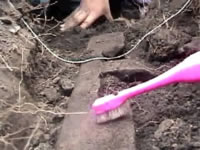Each group got a unit to work on. We started digging down to 10cm (one level) at a time, keeping the walls straight. If we found an artifact we drew the location of the artifact in our journal. Then we put the artifact in a paper bag labeled with the unit number, the quadrant and the level. All of the bags went to Andrea and she would give us a new bag for our quadrant for the next level.
"We always had to have a new artifact bag for each level that we dug. We had to record everything and draw exactly which quadrant it was found in. " |
Grade 4 student at Unit 2 |
All of the dirt we took out of the quadrant for the level went to the sieves to look for smaller artifacts that we missed at first. Sometimes we had to go to sift many times because our bucket was full.
"The tools we used were shovels to loosen the dirt, trowels to dig, hands to dust, and toothbrushes to clean. One group even brought a battery operated tooth brush to clean the smaller artifacts." |
Grade 4 student at Unit 9 |
|
|
We knew we were finished when we hit clay. When a group struck clay, you would finish the level you’re on and flatten out the entire hole including other people’s parts. We were hoping that when we hit clay, the clay would be mixed up with black soil. This is called "mottling" and means that the soil has been disturbed before, like it was dug up before and then replaced. You find this at graves or basements or cold cellars or other excavations.
"When we got down to clay in our unit, Andrea would come and see how far we had dug and how deep the clay seemed. We didn't find any artifacts in the clay. Digging the levels was hard because you had to dig 10 cm. at a time and then level the bottom off and straighten the sides." |
Grade 5 student at Unit 12 |
When we looked at the site after the bobcat owner scraped off the grass, we found a lot of metal objects poking up through the ground. These were scattered all across the site and we needed a good way to record where they were. We didn't want to extend the grid pattern all over the site for single items since we weren't going to open any of those units. We measured the distance of the artifact from two posts |
|



